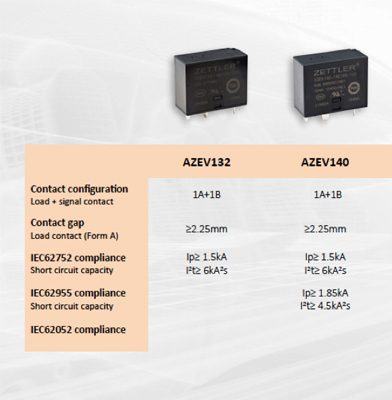|
E-mobility solutions for today and tomorrow The right relays, contactors, and the like for every charging application.Applications that involve the switching or carrying of large loads put special demands on the components used. Zettler offers a wide range of relays and contactors specifically designed for charging electric vehicles. The starting point
The trend away from the internal combustion engine and towards electromobility is continuing. The number of e-vehicles is growing globally – both plug-in hybrids and pure electric vehicles – and this strong growth is also driving the need for charging infrastructure. Electric vehicles can be charged in a variety of ways: at a private socket with single-phase or 3-phase 120VAC output and currents up to 16A, via a special charging socket connected to a stationary charger or a wallbox (peak current 80A, 20kW), or with fast charging DC at 200-600V and currents of up to 400A.
Safety takes precedence: products used for electric vehicle charging – such as wall-mounted charging stations or charging cables containing integrated electronics (ICCPD: in-cable control and protection device) – must comply with current standards including IEC62752 for ICCPD mode 2 charging and IEC61851-1 for mode 3 charging using wallboxes. Of the four charging modes standardised in EN ICE 61851, charging mode 2 in particular is a challenge for switching relays. The ICCPD electronics integrated into the charging cable are responsible for the safety and communication functions when connected to the mains network. The built-in relays, for example, must have a high short circuit withstand of up to 1.5kA. At such a high current load, electrodynamic forces occur that work against the contact force of the relay. In extreme cases, the temperature rises so much that the contacts can burn off during switching operations and thus lead to equipment failure caused by welding. Solutions and examples: EV series relays
The short circuit withstand of 1.5kA can be achieved in two ways. One comes from Zettler’s patented construction, which utilises a specially curved contact spring. This boosts the force on the contacts as the current increases, instead of working against it, and prevents the contacts from welding. Relays in the AZEV140 series thus allow switching currents of 40A and fulfil the required short circuit withstand of 1.5kA at holding power of 200mW.
Another way to meet the requirements of IEC62752 is to have a signal contact integrated into the relay. This indicates instantly if a short circuit occurs or if the contacts weld and cause the relay to fail. Charging is automatically and immediately interrupted. Zettler’s AZEV116/132/140 relays have a potential-free N.C. (1 Form B) signal contact. This approach allows switching currents of up to 20A maximum for the AZEV116, up to 40A for the AZEV132, and up to 50A for the AZEV140, with up to 1500A short circuit current (carrying) without welding.  | | Image 2: Comparison of the AZEV132 and AZEV140 series. |
|
Solutions and examples: contactors and sensors
Zettler’s range continues to include dedicated contactors for EV charging technology. For standard quick chargers, the XMCO series is used. These electromechanical switching devices have a high breaking capacity and are used to safely disconnect the charging circuit from the mains. The XMC0 is available in various pole configurations for loads up to 90A.
For control and monitoring applications, Zettler offers AC current sense transformers (ACST). These are used in protection circuits and load sensing systems to determine if the intended current is actually flowing or if the current deviates significantly, signalling an overload, structural damage, or other fault. Their main use is in 50Hz and 60Hz systems. The primary winding is integrated into the sensor; this saves assembly time and results in a tidy, compact component measuring just 20.0 x 17.8 x 23.8mm. The measurement signal is isolated from the primary AC side, allowing the sensor to be used at any point within the circuit. The magnitude of the sensor's output voltage can be adapted to the individual application by selecting a suitable RL value. For the ACST-265-10 and a load resistance of up to 60 Ohm, it is linear over the entire measurement range up to 36Arms.
A wide range of display and HMI solutions from Zettler group member AZ Displays – including TFT LCD, PM, and LED solutions – complete the portfolio At Schukat
At Schukat electronic we ensure that Zettler products are distributed quickly and easily both in Germany and across Europe. We have been working with the supplier for many years and offer their relays and other products direct from stock.
As a distributor, we provide fast, competent support with direct in-house contact persons; we also employ an expert field service team for on-site problem solving. Customers benefit from rapid processing of enquiries, availability of data sheets and samples, and variable delivery quantities – from samples to series production.
|
|
|














